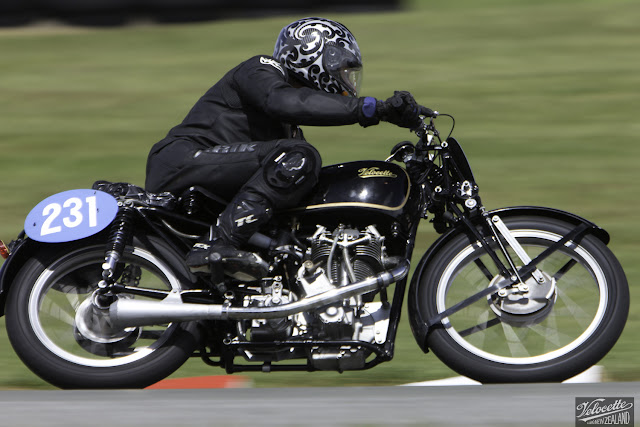Velocette KSS
This 1934 KSS incorporates classical Velocette features of black and gold paintwork, singlecylinder engine and fish-tail silencer. The tank logo highlights the firm ’.v trio of Isle of Man TT victories between 1929 and ’29. This model incorporates the saddle tank, uprated electrics and four-speed, foot-change gearbox that had made the KSS more sophisticated but heavier following the model’s introduction in 1925.
Velocette’s 350cc overhead camshaft single of the mid-1920s was one of the most successful designs the motorcycle world had seen. Percy Goodman’s creation, introduced by the Birmingham based Veloce Ltd as the Model K in 1925, not only performed brilliantly on the racetrack for more than 20 years, but formed the basis of sporting roadsters that were sold in large numbers for a similar period.
The ‘cammy’ (overhead-cam) Velocette’s initial impact came in competition at the Isle of Man TT, where in 1926 Alec Bennett crashed on the last lap but still won the 350cc Junior TT by more than ten minutes, at a 66.7mph (107.3km/h) average speed that would have given him second place in the 500cc Senior race. Velocette followed this with a second place in the Junior the following year, and two more wins in 1928 and ’29, with Bennett and Freddie Hicks.
Bennett’s TT winner was a lightly modified version of the original Model K production bike. This was followed late in 1925 by a new model, the KSS - standing for camshaft super sports. Like its predecessor the KSS featured a single overhead camshaft, driven by shaft and bevel gears. It produced 18bhp, was good for 80mph (129km/h), and had excellent acceleration partly because it weighed just 2201b (100kg) without lights.
In subsequent years the KSS was repeatedly updated, gaining refinements including a speedometer, larger saddle-style fuel tank, plus dynamo and battery electrics. It was also updated with a four-speed gearbox instead of the original three-speeder, plus the positive stop, foot-controlled gearchange that had been invented by Velocette development engineer Harold Wills, and introduced on the works racebikes in 1929.
Manx Grand Prix wins
In that year Velocette also broke new ground by introducing the KTT: another cammy 350, but an ‘over-the-counter’ production racer closely based on the works bike. It made a big impact, taking the first eight places in the following year’s Manx Grand Prix. Even more impressively, its descendent the KTT Mk VIII was still competitive two decades later. Freddie Frith and Bob Foster proved that in 1949 and ’50 by winning 350cc world titles on works double-overhead-cam (‘double-knocker’, in Harold Wills’ colourful parlance) versions of the single.
While the KTT got faster, the KSS, in becoming better equipped and more refined over the years, also became heavier and slower. In 1935 production was halted while the factory completed development of a KSS Mk II, which was released the following year. This had an aluminium cylinder head with fully-enclosed valvegear. plus an uprated lubrication system and new chassis
The KSS was a more sophisticated bike but its weight had grown to 3401b (154kg) and power output was unchanged at 18bhp. By this time Velocette’s simpler, pushrod-operated singles offered comparable power for less money, and the days of the KSS were numbered. After the Second World War, Velocette briefly built a KSS updated with telescopic forks instead of girders, but discontinued it in 1948.
Velocette’s choice of the KSS name stood for camshaft super sports, the use of K instead of C reflecting the Goodman family’s German origins.
Percy Goodman ’s 349cc singlecylinder engine used bevel drive to its single overhead camshaft, and produced I8bhp. Harold Willis’s positive-stop, four-speed gearbox was introduced to the KSS in 1932.
The MAC - 350cc Velo for the Masses
The KSS was a hit on road and track, but the 350cc single that made most profit for Veloce Ltd was its humbler pushrod-operated cousin, the MAC. Launched in 1933 as the 250cc MOV ('OV' standing for overhead valve), and enlarged to 349cc to create the MAC the following year, designer Charles Udall's pushrod single was much less expensive to produce, and became the mainstay of the range. The MAC remained in production until 1960, gaining telescopic forks, aluminium barrels and finally a twin-shock frame along the way. In 1935 it was joined by a 500cc version, the MSS.
Specification Velocette KSS (1934)
- Engine Air-cooled sohc two-valve single
- Capacity 349cc (74 x 81mm)
- Maximum power 18bhp @ 5800rpm
- Transmission Four-speed, chain final drive
- Frame Steel cradle
- Suspension Girder front; rigid rear
- Brakes Drum front and rear
- Weight 320lb (145kg)
- Top speed(road trim) 75mph (121km/h)


















0 comments: